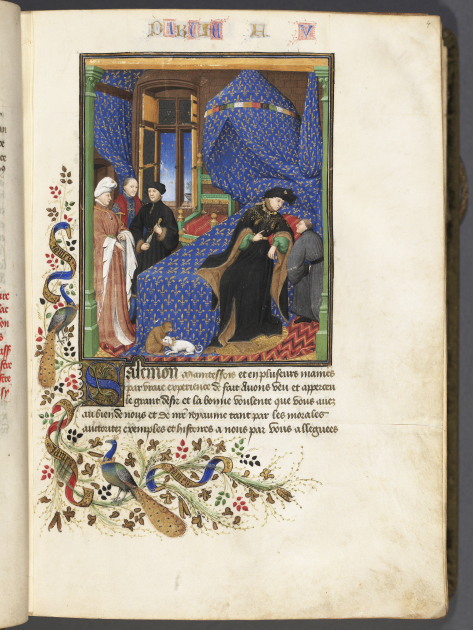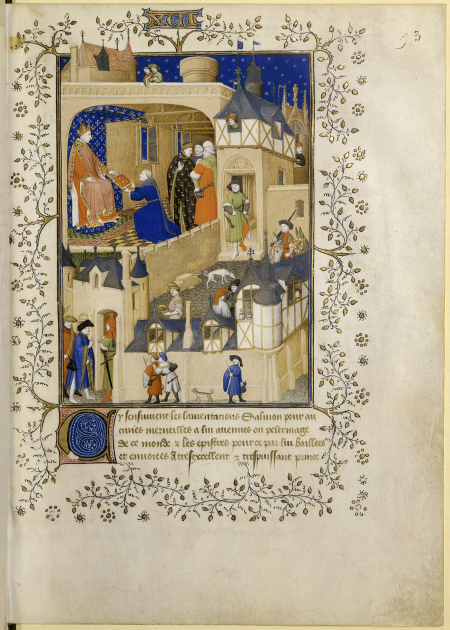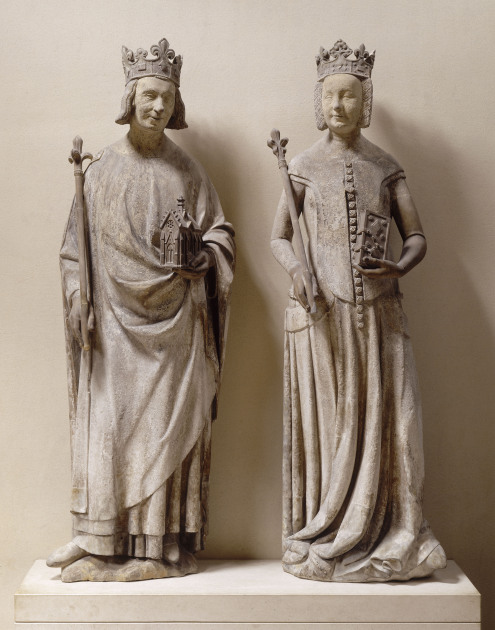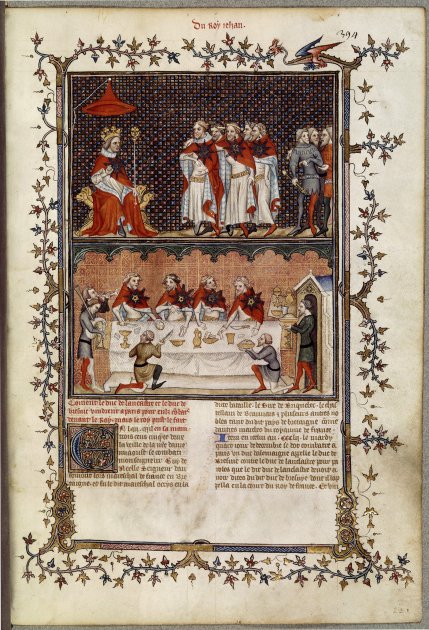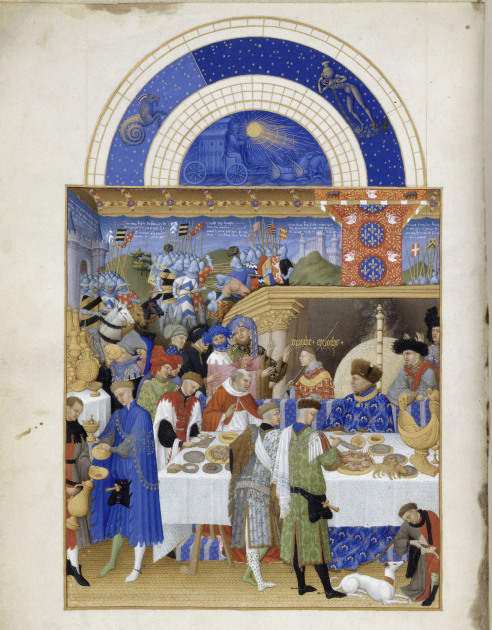Political rivalries over the control of the State
The emergence of princely factions
The growing power of monarchical institutions at the beginning of the 14th century raised the stakes for their control among the political elites who had or sought to have a share in power at the Royal Court. Above all, these court factions signalled the ambitions of the princes of the blood, as belonging to the royal family. Before acceding to the throne in 1328, the Valois already played an important part at the Council, notably with Charles of Valois, Philip VI's father. Under the first Valois a “Navarre party” gathered around the person of Charles of Navarre[1] a direct descendant of Philip the Fair[2] by his mother. He brought together lords from northern and southern France whom the king's policies had dissatisfied. This party succeeded in influencing the royal government's decisions by intermittently crowding the Council with its acolytes right up to the king of Navarre's removal after the defeat of Cocherel in 1364. In England, Richard II[3] Plantagenet's minority and weakness invited a multitude of plots that resulted in his being driven out by his first cousin Henry Bolingbroke[4] duke of Lancaster.
In France, Charles VI[5]'s minority then his madness allowed the king's uncles, Louis Duke of Anjou, John Duke of Berry and Philip Duke of Burgundy to take over the regency. From 1404, the king's brother Louis, Duke of Orléans and his first cousin John the Fearless[6] Duke of Burgundy were openly wrestling for the control of public finances, a control which had direct implications for the revenues they may reckon from their own principalities. In 1407, the latter had the former murdered. This blow triggered the feudal internal strife known as the Armagnac-Burgundian quarrel the ultimate object of which was the capture of royal government. Each time the princes' fortune turned, monarchic institutions were put through thorough purges, Council members, Councillors to the Parliament, Masters of Accounts, university professors would henceforth be appointed according to their partisan allegiance. After 1418 and the fall of Paris into English hands, the French central administration split into two. A government of Anglo-Burgundian obedience held out in Paris while a number of councillors and masters withdrew to Bourges and Poitiers around the Dauphin, later Charles VII, whose reign would in turn be tainted by the manoeuvres of several clans gravitating around him. In England, continental defeats after 1455 caused a resurgence of tensions which would lead to the War of the Roses between the royal houses of Lancaster and York.
 Informations[8]
Informations[8]Royal power and representative assemblies
The running of the State held little attraction for the princes. In the middle of the 14th century, new institutions appeared in France: the Estates[9]. The first were held in the northern provinces speaking the langue d'Oil in 1343. The Estates, which convened representatives from the aristocracy, the clergy and the towns, vouchsafed the elites' assent to extraordinary taxes. Now between 1355 and 1358, the factions who held sway were inclined to take advantage of the monarchy's predicament to impose their views, notably regarding the setting of the basis of assessment, the control of expenditures and the return to a more stable currency. However the royal authority reasserted itself and extinguished any hope of power sharing. The Estates sitting between 1420 and 1430 were more docile and voted subsidies that became annual the great weakness of royal power notwithstanding. Thereafter the Estates would only be called exceptionally which critically lessened their role.
In England, the crises that shook the kingdom were as many occasions for the Parliament to wrest concessions from the monarch. In 1340-41 at the time when the French campaign seemed to flag, Edward III[10] granted it extensive powers regarding extraordinary taxation. At the end of his reign in 1376, when the English only clung to a remnant of possessions in France (Calais, Cherbourg, Brest, Bordeaux and Bayonne, the « Good Parliament »
formalised the institution of an upper and lower chamber: the House of Lords where barons and clergy sat and the House of Commons[11] for the knights from the shires and burgesses from the towns. In order to organise its debates and ensure their impact, the House of Commons chose to be chaired by a Speaker who would also spoke in its name. The House of Commons further obtained the prerogative to resort to impeachment, a legal procedure enabling it to arraign and bring members of the Royal Council before Parliament to be judged. Under Richard II, in 1386-87, the king's feebleness gave Parliament ample room for manoeuvre; in 1399, it approved the dynastic change.
New forms of political involvement
At the turn of the 14th and 15th century, the princes and highest elites in both kingdoms exhibited the desire to influence the direction of a reinvigorated State apparatus. In order to intervene in the monarchic government – henceforward the source of all power – this political society updated the means of its action: for instance, the French aristocracy set up leagues in order to secure more liberties in the face of royal officers' encroachments on their privileges. Proximity to the king remained no less fundamental. In France, the management of public affairs, the attribution of an important position, say the king's lieutenantship of Languedoc, were often the preserve of Princes of the blood (or as they were called “of the fleur de lys”) closely related to the monarch. Matrimony was also a way to associate a high ranking family to the House of France and thus to decision-making. Royal power still relied on the multiple prescriptions of the feudal contract[12] to bind the high barons to its authority. Thus by the 1381 second treaty of Guérande, Charles VI acknowledged the hitherto English-backing House of Montfort in Brittany and received in return John IV[13]'s homage[14]. Over the following decades, the dukes of Brittany, restored to their high rank and access to power, were active in the struggles aimed at gaining control of the government.
 Informations[15]
Informations[15]At the same time, the kings more readily resorted to other ways of contractualizing their relationships with the great lords or with their staff, for instance by granting pensions, funding the upkeep of armed companies, the creation of chivalric orders[16] , such as the Order of the Star by John the Good. Though the princes relied on all the subtleties of the feudo-vassalic bonds in their mutual relationships, they showed prepared to form alliances the counterpart of which was not the handing over of a fiefdom. In 1410 the league of Gien gathered behind Bernard VII[17] of Armagnac a broad cluster of French princes made uneasy by the Duke of Burgundy's activities which, in their view, upset the balance of power. The Quarrel of the Armagnacs and the Burgundians invited the creation of signs of recognition on all sides: white scarf for the Armagnacs, red cross of Saint Andrew for the Burgundians. In Paris, the populace were enjoined to take side. Politicization beyond the higher social echelons looked to progress. This state of affairs may have reflected a rising awareness in people's mind of a State the future of which was of some moment to them.
 Informations[19]
Informations[19]Even the church found itself dragged in the French civil war, in the framework of the Western Schism. The Burgundians supported, along with the English, the Pope in Rome and obtained from the king as early as 1398, and again in 1407 the substraction of obedience, that is the withdrawal of the kingdom of France's obedience to the Pope in Avignon. As for the Armagnacs, they supported the Avignon Papacy. Thus, the clergy of northern France as a whole backed the Anglo-Burgundian camp until 1435, date at which Charles VII was reconciled with the Duke of Burgundy. As a case in point, Joan of Arc was sentenced in 1431 by a church tribunal presided over by Pierre Cauchon, Bishop of Beauvais and a Burgundian sympathizer. Even after 1417 and the end put to the Western Schism by the Council of Constance, the latter Avignon popes still found some support in Southern France up until 1430. However after 1438 and the reclaiming of English-controlled France, the clergy translated its Gallicanism into a fierce loyalty to the Valois.
Likewise in England, the high clergy ended up having to take side in the War of the Roses. In 1461, the bishop of London accepted to crown Edward IV of York[20] in Westminster even though Henry VI of Lancaster[21] was still legitimately his sovereign. However, in the succession crises of 1461, 1483 and 1485, the church played but a minor role as Parliament asserted its role as chief guarantor of monarchic legitimacy.


